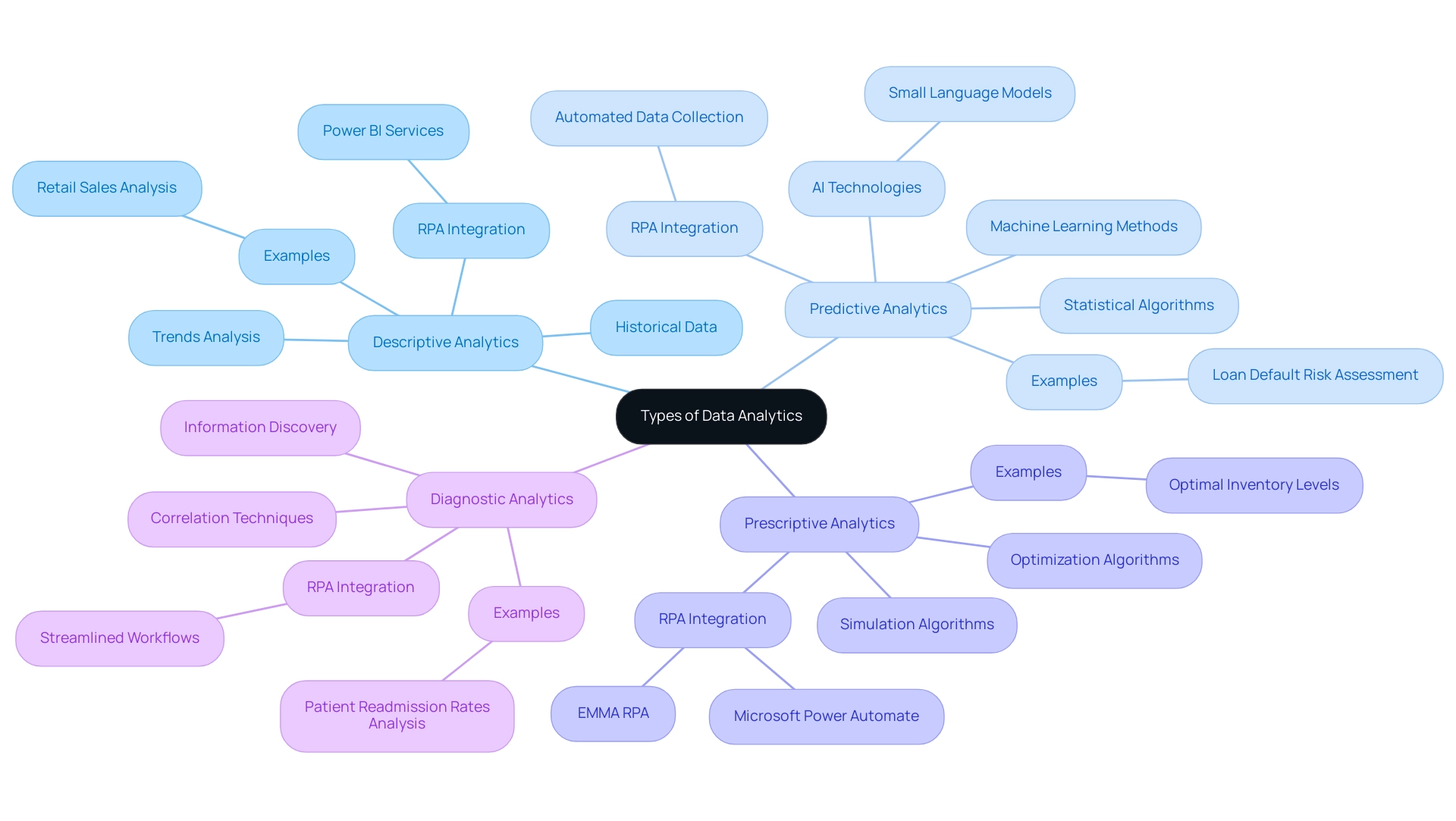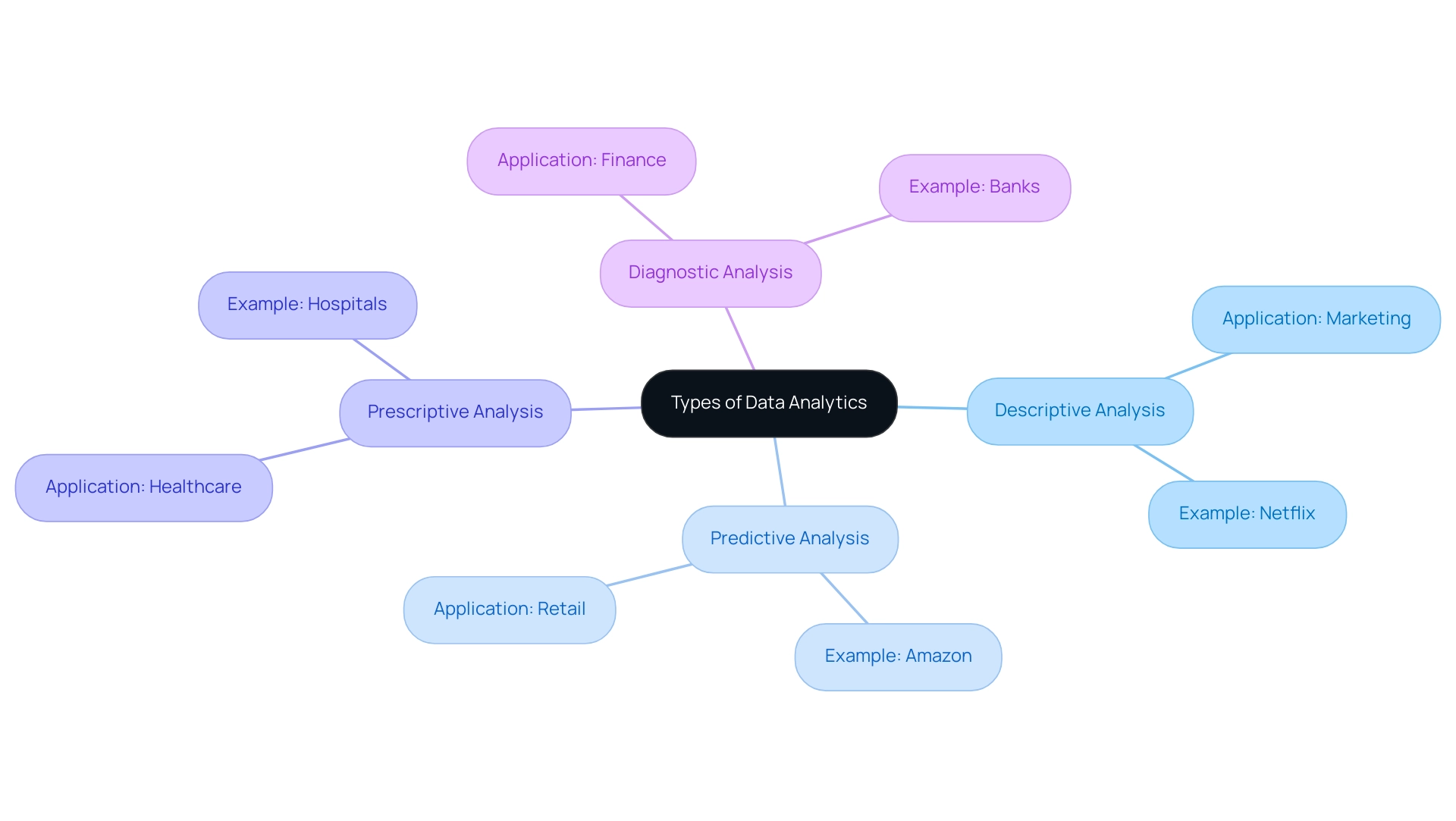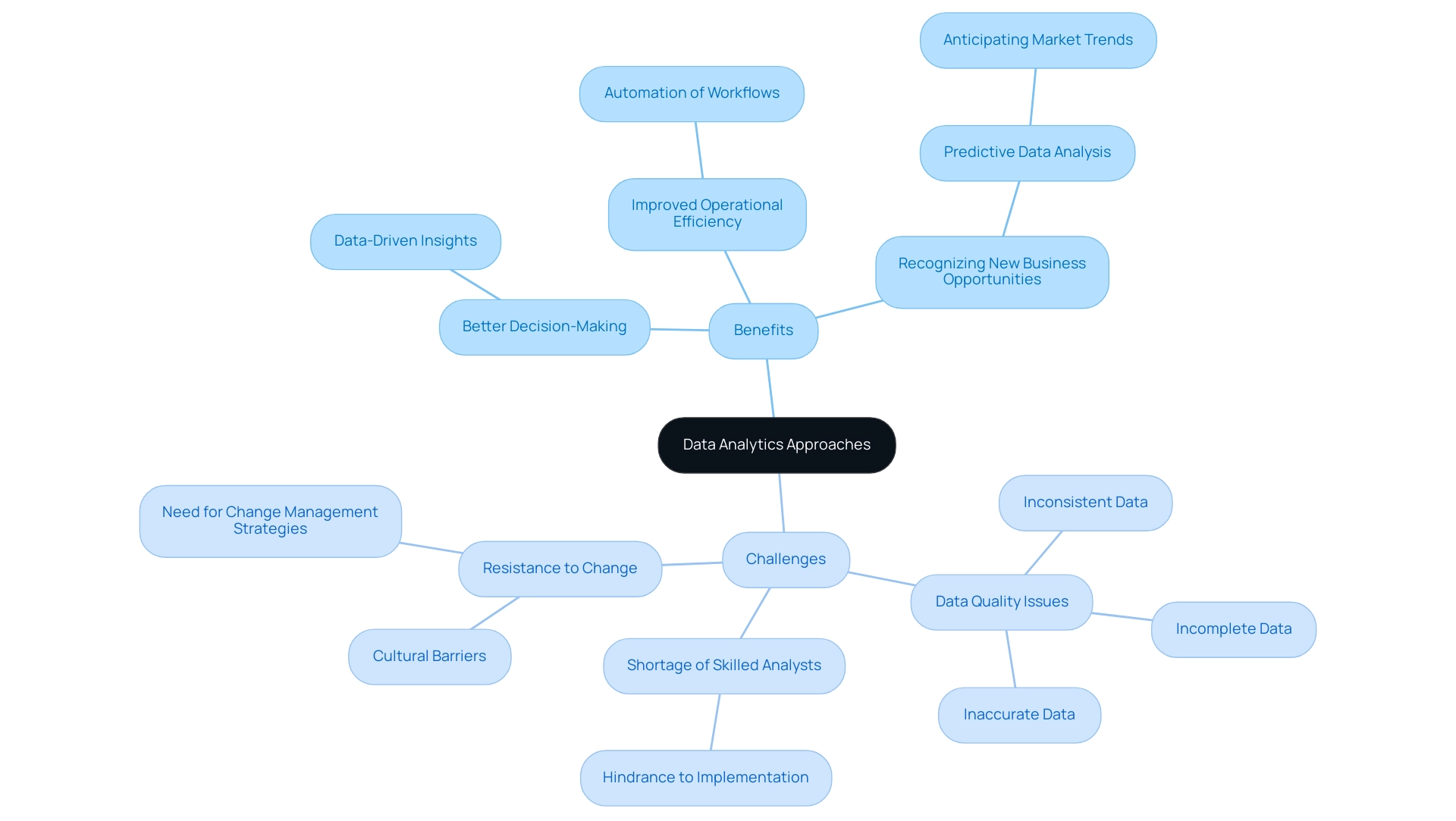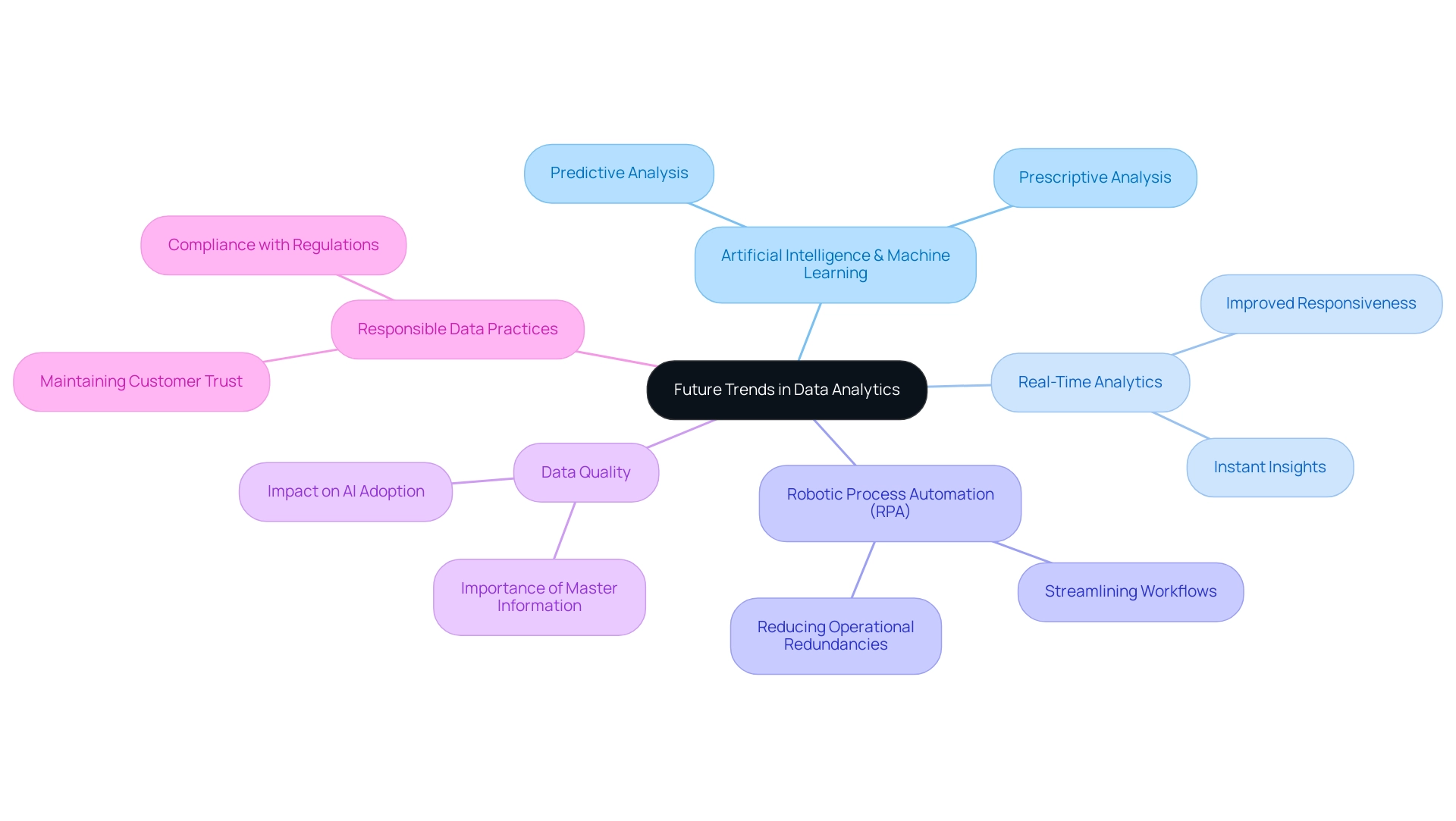Introduction
In a world increasingly driven by data, organizations that harness the power of analytics stand to gain a significant competitive advantage. Data analytics transforms vast amounts of raw information into actionable insights, enabling companies to optimize processes, enhance operational efficiency, and foster innovation.
As businesses face the dual challenges of navigating complex data landscapes and integrating advanced technologies, understanding the various types of analytics becomes essential. From descriptive to predictive, prescriptive, and diagnostic analytics, each type offers unique benefits that can drive informed decision-making.
However, the journey toward effective analytics implementation is not without its hurdles. By exploring practical solutions and leveraging tools like Robotic Process Automation (RPA) and tailored AI models, organizations can not only overcome these challenges but also position themselves for future success in an ever-evolving digital landscape.
Understanding Data Analytics: Definition and Importance
Data analysis involves the systematic computational examination of information, which encompasses types of data analytics with examples, aimed at discovering patterns, drawing conclusions, and supporting decision-making. In today’s information-rich environment, organizations leverage various types of data analytics with examples, including statistical analysis, to convert raw information into actionable insights, enabling them to optimize processes, enhance efficiency, and drive innovation. Overcoming common perceptions of AI as time-intensive and costly, our custom Small Language Models (SLMs) provide efficient, secure, and economical analysis tailored to specific industry needs.
Unlike traditional AI solutions, SLMs can be deployed on-premises, ensuring enhanced privacy and compliance while requiring less computational power, making them more affordable to implement and maintain. Furthermore, by implementing Robotic Process Automation (RPA), businesses can automate manual workflows, significantly enhancing operational efficiency. The significance of information analysis, specifically in the context of types of data analytics with examples, lies in its capacity to offer companies a competitive advantage, enabling informed decision-making and enhancing operational results through Business Intelligence.
As organizations increasingly depend on information to guide their strategies, understanding the different types of data analytics with examples becomes essential for success.

Exploring the Four Main Types of Data Analytics: Descriptive, Predictive, Prescriptive, and Diagnostic
- Descriptive Analytics: This is one of the types of data analytics with examples that focuses on summarizing historical information to understand what has occurred in the past. It frequently encompasses information aggregation and mining techniques to offer insights into trends and patterns. For instance, a retail firm might employ descriptive analysis to examine sales information from the prior year to pinpoint peak sales times. Power BI services enhance this process by ensuring efficient reporting and consistency, thereby providing clear, actionable guidance that can be further refined through RPA solutions.
Predictive analysis is one of the types of data analytics with examples, as it employs statistical algorithms and machine learning methods to determine the probability of future results based on historical information. For example, a financial organization might utilize predictive techniques to evaluate the risk of loan defaults by examining customer information and payment histories. Utilizing AI technologies, such as Small Language Models, can improve data quality and enhance the accuracy of these predictions, while RPA can automate data collection and processing, making the predictive assessment process more efficient.
-
Prescriptive Analysis: This is one of the types of data analytics with examples, as it goes a step further by recommending actions based on predictive analysis. It uses optimization and simulation algorithms to suggest the best course of action. For example, a supply chain manager may use prescriptive analysis to determine the optimal inventory levels to minimize costs while satisfying customer demand. Robotic Process Automation (RPA), particularly tools like EMMA RPA and Microsoft Power Automate, can facilitate these recommendations by automating the processes involved, enhancing operational efficiency and employee morale.
-
Diagnostic Analysis: This is one of the types of data analytics with examples, as it aims to clarify why an event occurred by examining historical performance. It frequently involves information discovery and correlation techniques. For example, a healthcare provider might use diagnostic analysis to identify the reasons for increased patient readmission rates by examining patient demographics and treatment histories. Integrating RPA solutions can streamline this workflow, allowing teams to focus on strategic, value-adding tasks instead of manual data processing. Additionally, utilizing AI-driven tools can further improve the quality of insights obtained from diagnostic analysis.

Real-World Applications: Examples of Each Type of Data Analytics
Descriptive analysis is one of the types of data analytics with examples that is commonly used in marketing to examine customer behavior and preferences. For instance, Netflix employs descriptive analysis to comprehend viewer demographics and viewing habits, enabling them to customize content suggestions. Integrating Robotic Process Automation (RPA) can enhance the efficiency of gathering and processing this information, minimizing manual efforts and reducing errors.
This is especially crucial in tackling the challenge of insufficient insight-driven information, as RPA can automate information collection processes, ensuring prompt and precise details.
Among the types of data analytics with examples, predictive analysis finds applications in various sectors, such as retail, where companies like Amazon utilize it to anticipate demand for products based on historical buying patterns, thereby enhancing inventory management. Implementing RPA solutions can automate information gathering processes, ensuring that predictive models are based on real-time information, which is essential in today’s rapidly evolving AI landscape. This capability assists businesses in staying ahead of market trends and making informed decisions.
In healthcare, prescriptive analysis is one of the types of data analytics with examples that is utilized to improve patient outcomes. For example, hospitals employ prescriptive analysis to identify the optimal treatment plans for patients based on historical treatment information and patient traits. RPA can streamline administrative tasks in this context, allowing healthcare professionals to focus on patient care rather than paperwork, thereby improving operational efficiency and patient satisfaction.
In finance, diagnostic analysis is an important example of the types of data analytics with examples that are widely applied. Banks examine transaction information to identify fraudulent activities. For example, a bank may use diagnostic analytics to investigate unusual spending patterns and flag them for further review.
The integration of Business Intelligence tools with RPA can significantly accelerate this process, transforming raw information into actionable insights that drive informed decision-making and enhance operational efficiency. By leveraging RPA, banks can enhance their fraud detection capabilities, addressing the challenges posed by increasingly sophisticated fraudulent activities.

Benefits and Challenges of Different Data Analytics Approaches
The advantages of information analysis include various types of data analytics with examples, which offer numerous benefits such as better decision-making, improved operational efficiency, and the capability to recognize new business opportunities. For example, organizations utilizing predictive data analysis, which is one of the types of data analytics with examples, can anticipate market trends, allowing them to stay ahead of competitors. However, challenges such as poor master information quality, the need for skilled personnel, and potential resistance to change remain prevalent.
- Inconsistent, incomplete, or inaccurate data can severely compromise insights.
- A shortage of skilled analysts may hinder effective analytics implementation.
- Furthermore, integrating AI solutions can seem daunting, but with tailored strategies and Robotic Process Automation (RPA) tools like EMMA RPA and Microsoft Power Automate, companies can overcome these barriers. These solutions not only automate manual workflows but also improve efficiency and accuracy.
Empowering employees through change management strategies fosters cooperation and engagement, ensuring a smoother transition to data-driven practices that significantly improve efficiency and drive growth.

Future Trends in Data Analytics: What Lies Ahead
As technology continues to progress, several trends are influencing the future of data analysis. The incorporation of artificial intelligence and machine learning is anticipated to improve predictive and prescriptive data analysis abilities, allowing organizations to make even more informed decisions. Furthermore, the rise of real-time analytics will allow businesses to act on insights instantaneously, improving responsiveness and agility.
In this rapidly evolving AI landscape, leveraging Robotic Process Automation (RPA) can significantly streamline manual workflows, reduce operational redundancies, minimize errors, and enhance overall efficiency.
By freeing up teams for more strategic, value-adding work, organizations can overcome the perceived complexities and costs often associated with AI adoption. Tailored solutions such as Small Language Models (SLMs) can offer efficient, secure, and cost-effective analysis. Furthermore, the growing emphasis on quality is vital, as poor master information can obstruct AI adoption and result in flawed decision-making.
Organizations must adopt responsible data practices to ensure compliance with regulations while maintaining customer trust. As businesses navigate these trends, those that embrace innovation and adapt to the evolving analytics landscape will be better positioned to thrive in a data-driven world, turning challenges into opportunities for growth. For effective implementation, consider starting with a consultation to explore how RPA and AI solutions can be tailored to your specific needs.

Conclusion
The power of data analytics is undeniable in today’s competitive landscape. By effectively harnessing various types of analytics—descriptive, predictive, prescriptive, and diagnostic—organizations can transform raw data into meaningful insights that drive informed decision-making and operational efficiency. The integration of tools such as Robotic Process Automation (RPA) and Small Language Models (SLMs) not only simplifies the analytics process but also enhances accuracy and reduces costs, making advanced data solutions accessible for businesses of all sizes.
While the journey toward effective analytics implementation may present challenges, such as data quality issues and the need for skilled personnel, these hurdles can be overcome with tailored strategies and the right technology. Embracing change management practices will empower teams to adopt data-driven methodologies that enhance productivity and foster innovation.
Looking ahead, the future of data analytics is bright, with advancements in AI and machine learning set to further refine predictive and prescriptive capabilities. Organizations that prioritize data quality and adaptability will be well-equipped to navigate the evolving landscape, turning potential challenges into opportunities for growth. By investing in the right analytics solutions, businesses can position themselves for sustained success in a data-driven world.
